
All text, charts & photos © Hilton Pond Center
2011 BIRD BANDING TOTALS:
HIGHEST IN NINE YEARS &
NINTH BEST EVER
Our 2011 banding year at Hilton Pond Center started at 10 a.m. on New Year's Day when we gathered a brown Purple Finch (above) of unknown sex from a sunflower seed trap hanging just outside the office window. The bird was followed at noon by seven Pine Siskins in the same trap. The PUFI was significant because it was followed in the next few months by 165 more of its species, but the seven PISI were the real portenders of what 2011 would be like. They figured prominently in helping us exceed 2,200 birds of 52 species banded during the just-completed calendar year.

All text, charts & photos © Hilton Pond Center
CHART 1: Click on image above to open a larger chart in a new browser window
To be exact, we banded 2,211 birds in 2011 (see Chart 1 above)--nearly a thousand more than last year's abysmal total--and well above the Center's 30-year average of 1,903 birds. We were pleased 2011 ended up being our best year since 2002, and that it was the ninth best since we started banding work in 1982. We could have done better on species diversity--52 species was our second-worst total for a full year of banding--but having spent so much time in the Neotropics studying Ruby-throated Hummingbirds and elsewhere doing consulting work, we managed to miss most of spring and fall migration and the accompanying assortment of warblers and other birds that pass through.
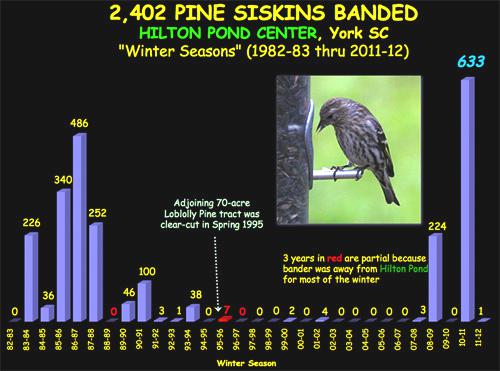
CHART 2: Click on image above to open a larger chart in a new browser window
Thus, we're thankful for all those Pine Siskins (see Chart 2 above). After handling 19 of them in December 2010 we banded 614 more between 1 January and 27 March 2011--easily eclipsing the previous annual high of 482 set 'way back in 1987 and giving us a winter-season total of 633. Such an abundance almost compensated for all those winters when we had no siskins at all.
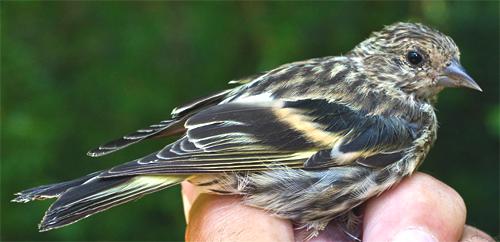
All text, charts & photos © Hilton Pond Center
Oddly, even though Pine Siskins were our most commonly banded species of 2011, one slightly scruffy immature PISI (above) turned out to be perhaps our most unusual banded bird for the year. 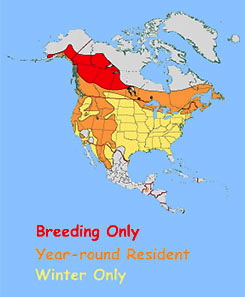 That's because this individual showed up in one of our sunflower seed traps on the ridiculously early date of 6 September--a month and a day ahead of the previous early fall arrival date for the entire state of South Carolina. The siskin disappeared shortly after banding--perhaps to fly back north to the boreal forest of Canada where many of its conspecifics undoubtedly were still hanging out. Pine Siskins don't breed anywhere near the southeastern U.S. (see map above left), so what this young bird was doing at Hilton Pond Center so early in autumn is anybody's guess. We also have no idea where the PISI were at year's end; that September bird was the only one we banded through December in the 2011-12 winter season. That's because this individual showed up in one of our sunflower seed traps on the ridiculously early date of 6 September--a month and a day ahead of the previous early fall arrival date for the entire state of South Carolina. The siskin disappeared shortly after banding--perhaps to fly back north to the boreal forest of Canada where many of its conspecifics undoubtedly were still hanging out. Pine Siskins don't breed anywhere near the southeastern U.S. (see map above left), so what this young bird was doing at Hilton Pond Center so early in autumn is anybody's guess. We also have no idea where the PISI were at year's end; that September bird was the only one we banded through December in the 2011-12 winter season.
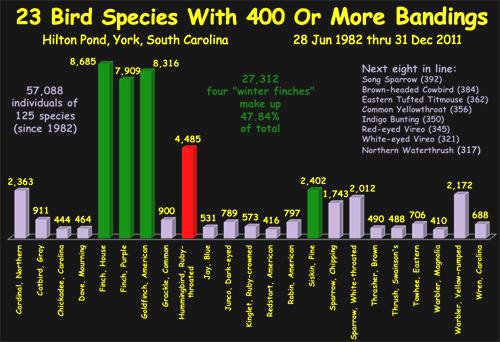
All text, charts & photos © Hilton Pond Center
CHART 3: Click on image above to open a larger chart in a new browser window
As one of four of what we call "winter" finches, Pine Siskins through the years have been our fifth most commonly banded species (see Chart 3 above), but they trail far behind the other three: House Finch, American Goldfinch, and Purple Finch. It's not completely accurate to lump HOFI as "winter" finches because they now breed across the Southeastern U.S.--as do quite a few American Goldfinches--but some midwinter individuals for both these species likely are migrants from up north. The average number of House Finches banded at the Center has declined significantly since their banner years in the early 1990s, and in 2011 we handled "only" 264. Add those 166 Purple Finches this year PLUS the bumper crop of 491 American Goldfinches, and we find that the four finches together equaled 1,554 bandings--or 70.3% of all new birds caught at the Center in 2011. That's a LOT of finches and a ratio that even exceeds their 30-year average of 47.84%. In other words, since 1982 almost half our local bandings have been those four finches, while in 2011 they made up almost three-quarters of the total.

All text, charts & photos © Hilton Pond Center
CHART 4: Click on image above to open a larger chart in a new browser window
After subtracting tallies for the four finches, our remaining 657 bandings were spread out over 48 species so it logically follows that none of those had such big numbers. Closest was Ruby-throated Hummingbirds, which crossed the banding table 197 times between 27 March (tying our early local record) and September 22 (our earliest-ever late record by almost a month). That's a nice number of RTHU for the Center, but considering we've topped 200 ruby-throats in six of the last eight years, we were a bit disappointed--especially since we set a new record last year with 239. The trend is upward for this species, however, and we were still far above our 28-year average of 160 hummers banded, and also above the 178 average for 22 "complete field seasons." (NOTE: Although we started banding 30 years ago at Hilton Pond Center, we did not get our hummingbird banding authorization until two years later on 27 July 1984.)
One other species with an unpredictable appearance record at Hilton Pond Center did show up in Autumn 2011: 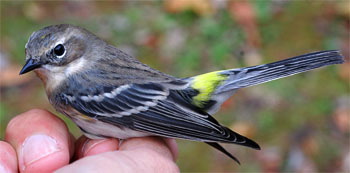 Yellow-rumped Warbler (below right), AKA Myrtle Warbler or "Butterbutt." This winter parulid, which breeds in Canada and Alaska and winters in the balmier lower 48 states, also occurred locally in big numbers in the early 1990s--425 banded in 1991 is our 30-year high--but MYWA have been mostly absent since then. We did net 142 back in 2007 and were pleased to band 101 in 2011. Yellow-rumped Warbler (below right), AKA Myrtle Warbler or "Butterbutt." This winter parulid, which breeds in Canada and Alaska and winters in the balmier lower 48 states, also occurred locally in big numbers in the early 1990s--425 banded in 1991 is our 30-year high--but MYWA have been mostly absent since then. We did net 142 back in 2007 and were pleased to band 101 in 2011.
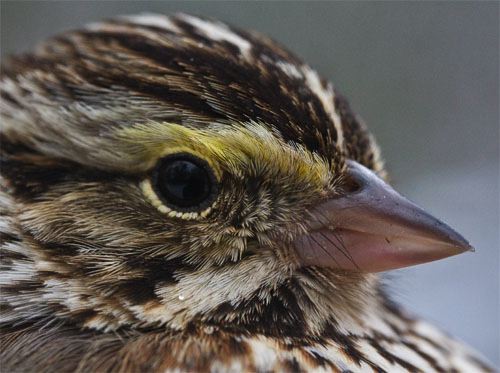
All text, charts & photos © Hilton Pond Center
We hadn't added a new species to list of banded birds since we caught a Cooper's Hawk in 2004, so we were particularly happy to get our 125th species: Savannah Sparrow (above). Eight of these were caught in ground traps during an early January snowstorm that brought in all sorts of birds. Savannah Sparrow was also a new "yard bird" for Hilton Pond Center, bringing the total species seen on or over the 11-acre property since 1982 to 170; of these, 25 are known to have nested locally.

All text, charts & photos © Hilton Pond Center
Two of those snow-driven January birds were of a species we seldom capture at Hilton Pond Center, even though they sometimes occur in big flocks during the winter. We speak here of Red-winged Blackbirds (adult male above), of which we've banded only 24 in 30 years. Most springs we hear male red-wings singing along the edge of Hilton Pond, but they always seem to move out before breeding. Without cattails and other dense vegetation, our pond edges probably don't provide optimal nesting habitat.
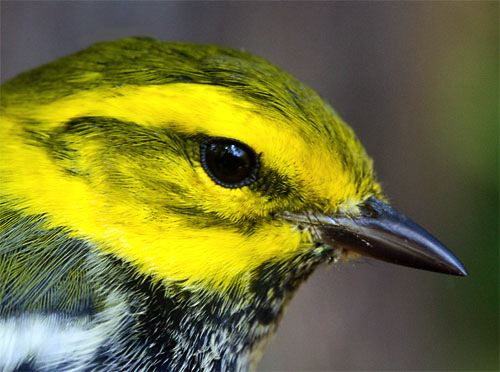
All text, charts & photos © Hilton Pond Center
Aside from those plentiful Pine Siskins and our one new species (Savannah Sparrow), only two other species set a new record high this year: 1) Carolina Chickadee, whose 35 bandings easily outstripped the old high of 24 established in 1990 and tied in 2007; and, 2) Black-throated Green Warbler (male above; banded five, old record was two). Chickadees and Black-throated Greens exceeded their 30-year averages but ten other species equaled or surpassed their averages, too; these are noted in Table 1 at the end of this photo essay.
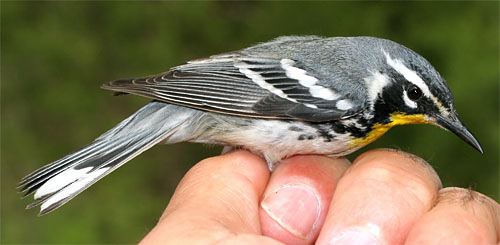
All text, charts & photos © Hilton Pond Center
With only 17 individuals captured since 1982, Black-throated Green Warbler was still only the "second-rarest" local species we handled this year. Even less common was a Yellow-throated Warbler (male above)--just our ninth banded since 1982. All in all, we did poorly on banding warblers in 2011, largely because we were away from the Center for much of spring and fall migration.
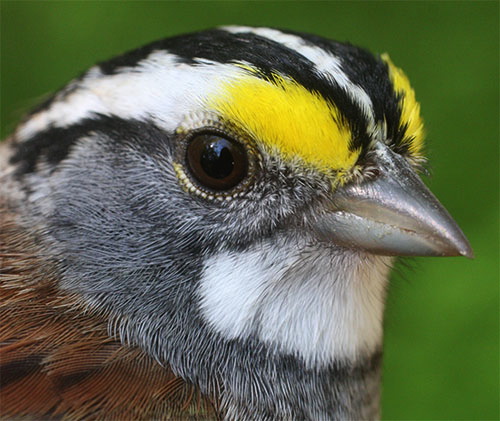
All text, charts & photos © Hilton Pond Center
We got no new members of the 400 Club this year (see Chart 3), but American Goldfinches moved up to the elite 8,000 Club and White-throated Sparrows joined the 2,000 Club--even though we banded only 21 of the latter. We did even worse with other ground-feeding birds including Eastern Towhee (just one banded), and several of brown birds that we expected but for which we handled zero individuals: Field Sparrow, Fox Sparrow, Swamp Sparrow, Brown Thrasher, and Northern Waterthrush. It's very likely a 30-year vegetational succession from old field to shrub land to young mixed forest at the Center has resulted in diminished numbers for many of these ground feeders.
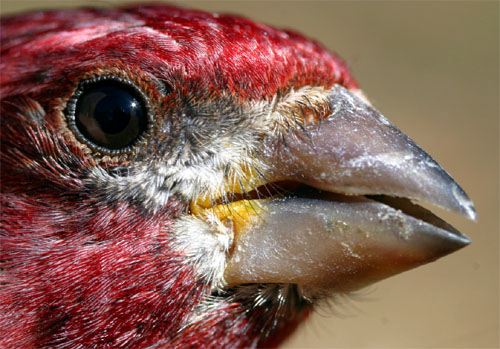
All text, charts & photos © Hilton Pond Center
And now a word about returns and foreign encounters. We band birds for lots of reasons, and the main intent isn't really to see how many we can capture in a year. Numbers do tell us something important, however, such as whether certain species might be irruptive or in decline. In that Hilton Pond Center is a permanent banding station, we have opportunities to learn many other things about birds we wouldn't know otherwise. Although many individuals we band are just moving through--never to be seen again--many of our resident species are recaptured locally at later dates. This tells us about site fidelity and also about longevity--as in the Purple Finch we banded as a brown immature in January 2004 and recaptured in January 2011 as a raspberry-colored nine-year-old adult male (above).
Equally impressive was a female Ruby-throated Hummingbird (below left) we banded in 2006 that returned in 2011--making her a sixth-year bird--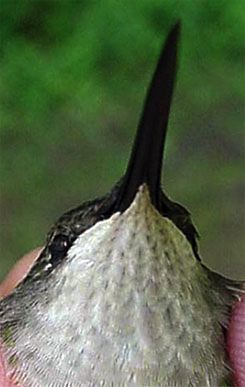 quite a feat for a tiny 3-gram bird that flies up to 2,000 miles to the Neotropics each autumn and back again in spring. (Incidentally, we caught her every year since since she was banded, indicating very strong site fidelity.) Also notable was another female RTHU also banded in 2006; she was already an adult back then, meaning she was an AFTER-sixth-year bird when trapped in 2011. (This individual wasn't caught from 2008-2010; who knows where she was those summers.) These two RTHU are truly impressive, but our most remarkable ruby-throat was yet another female, this one banded as an adult in 2005 and a regular recapture in our nets and traps every year but 2008. We caught her again in 2011, making her an after-seventh-year bird, i.e., in her eighth year of existence. The longevity mark for a banded, free-flying Ruby-throated Hummingbird is nine years, so all three of our "Methuselah hummers" recaptured this year still have a chance. We'll definitely be looking for them in 2012. quite a feat for a tiny 3-gram bird that flies up to 2,000 miles to the Neotropics each autumn and back again in spring. (Incidentally, we caught her every year since since she was banded, indicating very strong site fidelity.) Also notable was another female RTHU also banded in 2006; she was already an adult back then, meaning she was an AFTER-sixth-year bird when trapped in 2011. (This individual wasn't caught from 2008-2010; who knows where she was those summers.) These two RTHU are truly impressive, but our most remarkable ruby-throat was yet another female, this one banded as an adult in 2005 and a regular recapture in our nets and traps every year but 2008. We caught her again in 2011, making her an after-seventh-year bird, i.e., in her eighth year of existence. The longevity mark for a banded, free-flying Ruby-throated Hummingbird is nine years, so all three of our "Methuselah hummers" recaptured this year still have a chance. We'll definitely be looking for them in 2012.
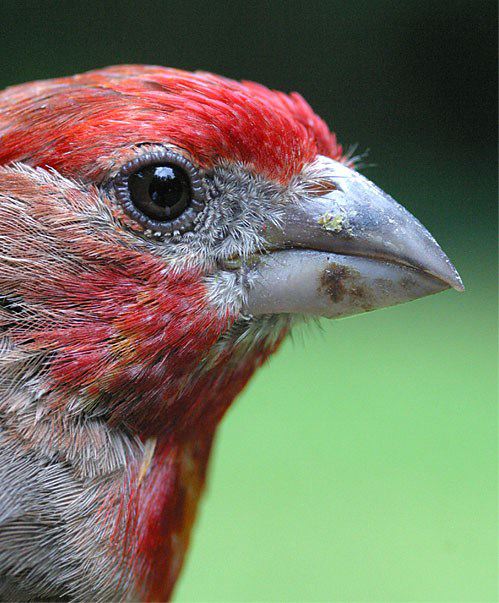
Aside from site fidelity and longevity data the big pay-off for bird banders, of course, is when a bird is found away from its banding site--something that seldom happens with our birds from Hilton Pond Center. This year we got word of two so-called "foreign encounters" outside our South Carolina home county of York. The first was a male House Finch (above) banded 30 December 2010 and found dead 24 May 2011 at Belmont NC, only about 20 miles to our north. The second was a true long-distance migrant, a female American Goldfinch banded on 19 April this year at the Center and recaptured by another bander barely a month later on 22 May at Chestertown MD--a straight-line distance of about 408 miles.
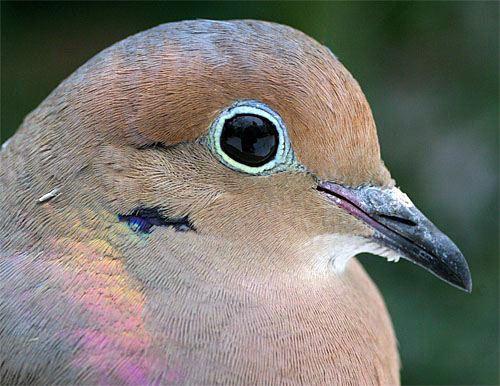
All text, charts & photos © Hilton Pond Center
This year we also had two of our banded birds encountered within York County: 1) a male American Goldfinch found dead a few miles from the Center a month after its January banding; and, 2) a Mourning Dove banded on 2 July and legally shot by a hunter on 3 September at Clover, about ten miles up the road. During our 30 years of banding we've had 34 in-county encounters, plus 56 outside York County.
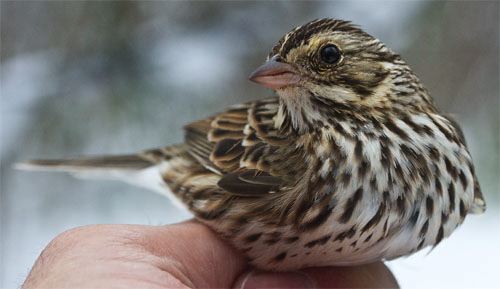
All text, charts & photos © Hilton Pond Center
Local habitat change since 1982 has indeed affected the numbers and kinds of birds we're banding these days at Hilton Pond Center--as has a reduced number of nets and net hours. Back in the "glory years" of the early 1990s we operated 20-plus mist nets dawn to dusk on most fair-weather days and several traps all winter, while for the past decade we have been more restricted by travel and other factors and have run only a half-dozen nets and fewer traps. Nonetheless, 2011 turned out to be pretty busy at the banding table, with one new bird for the Center (Savannah Sparrow, above), three other species with record highs, and a final tally that made it the most productive banding year in nine years and our ninth best ever. This kind of success gives us ample incentive to continue into 2012 for our 31st year as the most active year-round banding station in the Carolinas.
All text, charts & photos © Hilton Pond Center

All contributions are tax-deductible
TABLE 1: ANNUAL (2011) and CUMULATIVE (30-year)
BIRD BANDING TOTALS FOR HILTON POND CENTER
12 species in GREEN were banded at a rate at or above our 30-year average; species in BLACK were below average. Four species in RED set new record highs or tied old ones.
SPECIES |
2011
Total |
30-Year
Maximum |
30-Year
Average |
30-Year
Total |
| Blackbird, Red-winged |
2 |
5 |
1 |
24 |
| Blackbird, Rusty |
. |
3 |
<1 |
4 |
| Bluebird, Eastern |
3 |
32 |
9 |
260 |
| Bunting, Indigo |
3 |
52 |
12 |
350 |
| Cardinal, Northern |
64 |
157 |
79 |
2,363 |
| Catbird, Gray |
1 |
114 |
30 |
911 |
| Chat, Yellow-breasted |
. |
24 |
5 |
135 |
| Chickadee, Carolina |
35 |
35
(old record 24 in 2007)
|
15 |
444 |
| Cowbird, Brown-headed |
3 |
90 |
13 |
384 |
| Creeper, Brown |
. |
3 |
<1 |
8 |
| Cuckoo, Black-billed |
. |
1 |
<1 |
2 |
| Cuckoo, Yellow-billed |
. |
18 |
2 |
55 |
| Dove, Mourning |
13 |
44 |
15 |
464 |
| Finch, House |
264 |
715 |
290 |
8,685 |
| Finch, Purple |
166 |
950 |
264 |
7,909 |
| Flicker, Northern |
. |
9 |
1 |
35 |
| Flycatcher, Acadian |
3 |
18 |
4 |
119 |
| Flycatcher, Great Crested |
1 |
6 |
2 |
49 |
| Flycatcher, Least |
. |
2 |
<1 |
4 |
| Flycatcher, Yellow-bellied |
. |
2 |
<1 |
2 |
| Flycatcher, Willow |
. |
3 |
<1 |
3 |
| Gnatcatcher, Blue-gray |
. |
20 |
4 |
130 |
| Goldfinch, American |
491 |
838 |
277 |
8,316 |
| Grackle, Common |
. |
164 |
30 |
900 |
| Grosbeak, Blue |
. |
6 |
2 |
65 |
| Grosbeak, Evening |
. |
49 |
3 |
87 |
| Grosbeak, Rose-breasted |
. |
5 |
2 |
45 |
| Hawk, Cooper's |
. |
1 |
<1 |
2 |
| Hawk, Red-shouldered |
. |
3 |
<1 |
9 |
| Hawk, Sharp-shinned |
. |
6 |
1 |
39 |
| Heron, Green |
. |
3 |
<1 |
11 |
Hummingbird, Ruby-throated
(banding began 1984)
|
197 |
239
|
160
(28 years)
|
4,485
(28 years) |
| Hummingbird, Rufous |
. |
1 |
<1 |
2 |
| Jay, Blue |
4 |
65 |
18 |
531 |
| Junco, Dark-eyed |
21 |
74 |
26 |
789 |
| Kingbird, Eastern |
. |
4 |
<1 |
11 |
| Kingfisher, Belted |
. |
3 |
<1 |
9 |
| Kinglet, Golden-crowned |
5 |
41 |
5 |
161 |
| Kinglet, Ruby-crowned |
3 |
81 |
19 |
573 |
| Meadowlark, Eastern |
. |
1 |
<1 |
1 |
| Mockingbird, Northern |
4 |
24 |
6 |
168 |
| Nuthatch, Brown-headed |
. |
10 |
2 |
48 |
| Nuthatch, Red-breasted |
. |
3 |
<1 |
11 |
| Nuthatch, White-breasted |
. |
4 |
1 |
18 |
| Oriole, Baltimore |
. |
2 |
<1 |
6 |
| Oriole, Orchard |
. |
13 |
2 |
54 |
| Ovenbird |
2 |
42 |
7 |
219 |
| Owl, N. Saw-whet |
. |
7 |
<1 |
10 |
| Pewee, E. Wood- |
. |
16 |
4 |
107 |
| Phoebe, Eastern |
5 |
36 |
9 |
273 |
| Redstart, American |
7 |
57 |
14 |
416 |
| Robin, American |
38 |
171 |
27 |
797 |
| Sapsucker, Yellow-bellied |
. |
7 |
1 |
43 |
| Screech-Owl, Eastern |
. |
1 |
<1 |
2 |
| Shrike, Loggerhead |
. |
1 |
<1 |
1 |
| Siskin, Pine |
615 |
615
(old record 482 in 1987)
|
80 |
2,402 |
| Sparrow, Chipping |
42 |
145 |
58 |
1,743 |
| Sparrow, Field |
. |
44 |
10 |
289 |
| Sparrow, Fox |
. |
8 |
1 |
41 |
| Sparrow, Grasshopper |
. |
1 |
<1 |
2 |
| Sparrow, House |
. |
5 |
<1 |
9 |
| Sparrow, Lincoln's |
. |
2 |
<1 |
6 |
Sparrow, Savannah
(new species in 2011) |
8 |
8 |
<1 |
8 |
| Sparrow, Song |
2 |
34 |
13 |
392 |
| Sparrow, Swamp |
. |
12 |
2 |
71 |
| Sparrow, White-crowned |
. |
2 |
<1 |
3 |
| Sparrow, White-throated |
21 |
167 |
67 |
2,012 |
| Starling, European |
. |
2 |
<1 |
7 |
| Swift, Chimney |
0 |
4 |
1 |
18 |
| Tanager, Scarlet |
3 |
13 |
3 |
102 |
| Tanager, Summer |
2 |
18 |
6 |
183 |
| Thrasher, Brown |
. |
59 |
16 |
490 |
| Thrush, Gray-cheeked |
6 |
14 |
4 |
106 |
| Thrush, Hermit |
3 |
35 |
6 |
189 |
| Thrush, Swainson's |
10 |
65 |
16 |
488 |
| Thrush, Wood |
. |
27 |
6 |
189 |
| Titmouse, Eastern Tufted |
16 |
26 |
12 |
362 |
| Towhee, Eastern |
5 |
85 |
24 |
706 |
| Veery |
1 |
15 |
3 |
98 |
| Vireo, Philadelphia |
. |
1 |
<1 |
2 |
| Vireo, Red-eyed |
4 |
49 |
12 |
345 |
| Vireo, Blue-headed (Solitary) |
. |
4 |
1 |
18 |
| Vireo, White-eyed |
. |
40 |
11 |
321 |
| Vireo, Yellow-throated |
. |
5 |
1 |
39 |
| Warbler, Bay-breasted |
. |
3 |
<1 |
12 |
| Warbler, Black-and-White |
3 |
21 |
5 |
159 |
| Warbler, Black-throated Blue |
1 |
24 |
6 |
169 |
| Warbler, Black-throated Green |
5 |
5
|
1 |
17 |
| Warbler, Blackburnian |
. |
1 |
<1 |
2 |
| Warbler, Blackpoll |
. |
40 |
4 |
125 |
| Warbler, Blue-winged |
. |
4 |
1 |
23 |
| Warbler, Canada |
. |
5 |
1 |
32 |
| Warbler, Cape May |
. |
45 |
3 |
100 |
| Warbler, Chestnut-sided |
2 |
14 |
3 |
79 |
| Warbler, Connecticut |
. |
3 |
<1 |
3 |
| Warbler, Golden-winged |
. |
2 |
<1 |
4 |
| Warbler, Hooded |
. |
9 |
2 |
50 |
| Warbler, Kentucky |
. |
6 |
1 |
20 |
| Warbler, Magnolia |
. |
55 |
14 |
410 |
| Warbler, Nashville |
. |
2 |
<1 |
8 |
| Warbler, Orange-crowned |
. |
1 |
<1 |
4 |
| Warbler, Palm (yellow race) |
. |
20 |
2 |
56 |
| Warbler, Parula (N. Parula) |
3 |
7 |
2 |
62 |
| Warbler, Pine |
4 |
23 |
5 |
156 |
| Warbler, Prairie |
. |
9 |
1 |
39 |
| Warbler, Prothonotary |
. |
4 |
1 |
16 |
| Warbler, Swainson's |
. |
2 |
<1 |
2 |
| Warbler, Tennessee |
1 |
30 |
3 |
77 |
| Warbler, Wilson’s |
. |
2 |
<1 |
4 |
| Warbler, Worm-eating |
1 |
13 |
2 |
50 |
| Warbler, Yellow |
. |
5 |
1 |
21 |
| Warbler, Yellow-rumped |
101 |
425 |
72 |
2,172 |
| Warbler, Yellow-throated |
1 |
2 |
<1 |
9 |
| Waterthrush, Louisiana |
2 |
8 |
2 |
45 |
| Waterthrush, Northern |
. |
44 |
11 |
317 |
| Waxwing, Cedar |
3 |
44 |
8 |
251 |
| Woodcock, American |
. |
1 |
<1 |
1 |
| Woodpecker, Downy |
4 |
18 |
6 |
177 |
| Woodpecker, Hairy |
. |
5 |
1 |
24 |
| Woodpecker, Pileated |
. |
1 |
<1 |
1 |
| Woodpecker, Red-bellied |
1 |
9 |
3 |
81 |
| Wren, Carolina |
11 |
62 |
23 |
688 |
| Wren, House |
. |
11 |
2 |
64 |
| Wren, Winter |
. |
2 |
<1 |
12 |
| Yellowthroat, Common |
2 |
51 |
12 |
356 |
| [Duck, Wood]* |
. |
. |
. |
. |
| [Bobwhite, Northern]* |
. |
. |
. |
. |
| * = Captured by not banded, per Bird Banding Laboratory restrictions on game birds |
. |
. |
. |
. |
Total 2011 Species = 52
(30-year avg. = 67.8)
30-Year Species Total = 125 |
2011
Total
2,211 |
. |
30-Year
Avg.
1,903 |
30-Year
Total
57,088 |
|
All text, charts & photos © Hilton Pond Center

All contributions are tax-deductible
|
 The Piedmont Naturalist, Volume 1 (1986)--long out-of-print--has been re-published by author Bill Hilton Jr. as an e-Book downloadable to read on your iPad, iPhone, Nook, Kindle, or desktop computer. Click on the image at left for information about ordering. All proceeds benefit education, research, and conservation work of Hilton Pond Center for Piedmont Natural History.
The Piedmont Naturalist, Volume 1 (1986)--long out-of-print--has been re-published by author Bill Hilton Jr. as an e-Book downloadable to read on your iPad, iPhone, Nook, Kindle, or desktop computer. Click on the image at left for information about ordering. All proceeds benefit education, research, and conservation work of Hilton Pond Center for Piedmont Natural History.

 Every new member who registers with iGive and makes a purchase through them earns an ADDITIONAL $5 for the Center. You can even do Web searches through iGive and earn a penny per search--sometimes TWO--for the cause!Please enroll by going to the iGive Web site. It's a painless, important way for YOU to support our on-going work in conservation, education, and research. Add the iGive Toolbar to your browser and register Operation RubyThroat as your preferred charity to make it even easier to help Hilton Pond Center when you shop.
Every new member who registers with iGive and makes a purchase through them earns an ADDITIONAL $5 for the Center. You can even do Web searches through iGive and earn a penny per search--sometimes TWO--for the cause!Please enroll by going to the iGive Web site. It's a painless, important way for YOU to support our on-going work in conservation, education, and research. Add the iGive Toolbar to your browser and register Operation RubyThroat as your preferred charity to make it even easier to help Hilton Pond Center when you shop.





 That's because this individual showed up in one of our sunflower seed traps on the ridiculously early date of 6 September--a month and a day ahead of the previous early fall arrival date for the entire state of South Carolina. The siskin disappeared shortly after banding--perhaps to fly back north to the boreal forest of Canada where many of its conspecifics undoubtedly were still hanging out. Pine Siskins don't breed anywhere near the southeastern U.S.
That's because this individual showed up in one of our sunflower seed traps on the ridiculously early date of 6 September--a month and a day ahead of the previous early fall arrival date for the entire state of South Carolina. The siskin disappeared shortly after banding--perhaps to fly back north to the boreal forest of Canada where many of its conspecifics undoubtedly were still hanging out. Pine Siskins don't breed anywhere near the southeastern U.S. 

 Yellow-rumped Warbler
Yellow-rumped Warbler 





 quite a feat for a tiny 3-gram bird that flies up to 2,000 miles to the Neotropics each autumn and back again in spring.
quite a feat for a tiny 3-gram bird that flies up to 2,000 miles to the Neotropics each autumn and back again in spring. 



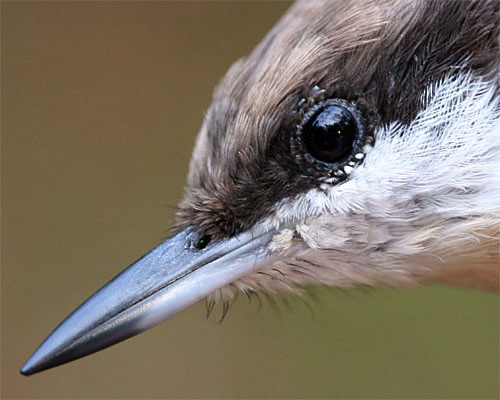

 Oct 15 to Mar 15:
Oct 15 to Mar 15: